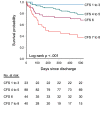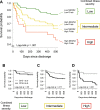Association between clinical frailty, illness severity and post-discharge survival: a prospective cohort study of older medical inpatients in Norway
- PMID: 34417977
- PMCID: PMC8379589
- DOI: 10.1007/s41999-021-00555-8
Association between clinical frailty, illness severity and post-discharge survival: a prospective cohort study of older medical inpatients in Norway
Abstract
Purpose: Study associations between frailty, illness severity and post-discharge survival in older adults admitted to medical wards with acute clinical conditions.
Methods: Prospective cohort study of 195 individuals (mean age 86; 63% females) admitted to two medical wards with acute illness, followed up for all-cause mortality for 20 months after discharge. Ward physicians screened for frailty and quantified its degree from one to eight using Clinical Frailty Scale (CFS), while clinical illness severity was estimated by New Early Warning Score 2 (NEWS2) and laboratory illness severity was calculated by a frailty index (FI-lab) using routine blood tests.
Results: CFS, NEWS2 and FI-lab scores were independently associated with post-discharge survival in an adjusted Cox proportional hazards model with age, ward category (acute geriatric and general medical) and comorbidity as covariates. Adjusted hazard ratios and 95% confidence intervals were 1.54 (1.24-1.91) for CFS, 1.12 (1.03-1.23) for NEWS2, and 1.02 (1.00-1.05) for FI-lab. A frailty × illness severity category interaction effect (p = 0.003), suggested that the impact of frailty on survival was greater in those experiencing higher levels of illness severity. Among patients with at least moderate frailty (CFS six to eight) and high illness severity according to both NEWS2 and FI-lab, two (13%) were alive at follow-up.
Conclusion: Frailty screening aided prognostication of survival following discharge in older acutely ill persons admitted to medical wards. The prognostic value of frailty increased when combined with readily available illness severity markers acquired during admission.
Keywords: Acute care; Clinical Frailty Scale; Frailty index; Hospital complications; New Early Warning Score; Survival analysis.
© 2021. The Author(s).
Conflict of interest statement
Kenneth Rockwood (KR) is Co-founder of Ardea Outcomes, which (as DGI Clinical) in the last 3 years has contracts with pharma and device manufacturers on individualized outcome measurement. All other authors declare no conflicts of interest.
Figures



References
Publication types
MeSH terms
LinkOut - more resources
Full Text Sources
Miscellaneous
